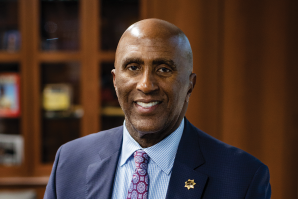Career moves don’t get better than those Jan Peters made midway through college. Peters is German, and in the late 1990s he was studying to become an aerospace engineer at a technical institute but switched to computer programming when the aerospace market softened. When he graduated in June 2000, he had three job offers. He chose a company that had entered the German market two years earlier by buying an online bookstore. He became employee number 68 at the German-language division of Amazon, working out of Munich.
He started accruing Amazon shares through the company’s benefits plan. They weren’t worth much at first. But by the time he left in 2010 to work at BMW across the street, he had 1,029 shares of Amazon stock in a Charles Schwab account. He planned to leave them there until he retired.
Fast forward to 2020, and he started getting emails from grifty-sounding companies telling him that his Amazon stock had been lost and that they’d help him get it back for a cut of the proceeds. A former colleague called to say he, too, was getting strange emails about Peters’ Amazon stock.
So Peters logged onto his Schwab account — and found a balance of zero. All of his stocks were gone. A Schwab representative told him that they had been turned over to the California state controller. “It was devastating,” Peters says.
Under California’s unclaimed property law, financial assets that an owner hasn’t interacted with for three years — making no deposits or withdrawals and not communicating with the financial institution that holds them — are considered abandoned. By law, Schwab had to turn them over to the controller’s office to hold while the office attempted to reunite them with the rightful owner, a process known as escheatment.
Peters called the controller’s office. The news got worse: Instead of holding Peters stocks, the state had sold them in 2017 at the then-current value of $1.6 million, which is how much would be returned to him. The trouble is that today, they’re worth about $4.2 million. The controller’s seizure and sale has cost him $2.6 million, leaving Peters a little more than a third of what he was counting on for retirement.
The state’s unclaimed property law is supposed to reunite abandoned assets with their owners. But another aim has long since taken over, say experts and attorneys for victims. In reality, the controller’s office finds owners for only a portion of the property it seizes. The rest gets sold off, and the resulting mountain of cash gets funneled into the state treasury. Today, that general fund benefits from $13 billion in proceeds from the sale of unclaimed property, which it uses to bolster the state budget. A 2015 state legislative analyst’s office report concluded that unclaimed property was the state’s fifth-largest source of annual revenue.
Far from making diligent efforts to reunite owners and property, the controller’s office does the minimum, say victims advocates. When the state is looking for people to pay taxes or fines, it uses the Department of Motor Vehicles and other private databases to track them down, says Peter’s attorney William Palmer, head of Palmer Law Group in Sacramento. But when seeking out people to notify them of the seizure of their assets, it relies solely on the state’s tax database — which doesn’t work for many asset owners who live outside California.
“In essence, it’s a no-interest loan to the state of California,” says Palmer. “And it’s not in the state’s best interest to let people know that they’re holding their property.”
But Palmer alleges that the state did something much worse in Peters’ case — it created a fictional mailing address for him, to which it sent the required notice that it had seized his stocks. That letter was addressed to “Munich, CA 00000,” according to a lawsuit Peters filed against State Controller Malia Cohen. Palmer says the testimony he’s obtained will prove that the address mistake was deliberate, and he points to the cases of other foreign citizens whose addresses he says were also falsified. On June 5, Palmer petitioned the U.S. Supreme Court to take the case. If he prevails, the consequences for the state treasury could be dire.
How we got here
Escheatment is not new: All states have unclaimed property laws for a reason. Say a grandparent bought stocks in your name many years ago and passed away. Your parents lost track of them, and now they’re sitting with the broker. Unclaimed property laws require the broker to turn over the stocks to the state, which sends you a notice to get them back. The state is supposed to make its best effort to find owners.
California’s escheatment laws date to the 1870s and were used in the 1890s to take control of dormant accounts at banks that were shutting down. In 1959 the state adopted a new law to cover other types of assets like abandoned travelers checks, safe deposit boxes and more.
Along the way, officials began viewing unclaimed property as a revenue source, the evidence shows. The state legislature cut the amount of time that assets could sit dormant before being considered abandoned: 15 years in 1959, seven years in 1976 and three years by 1990. In 2003 the state stopped paying interest on the value of unclaimed assets.
“The central purpose of this whole program is to reunite property owners with their property. The secondary purpose is to give the state the use of the property while they’re locating the owner. California, because of its budget problems, has flip-flopped the purposes.”
William Palmer, attorney, Palmer Law Group
Palmer started investigating the state’s use of the unclaimed property law after a private investigator in Sacramento tipped him off. “It was kind of virgin territory. There weren’t a lot of people looking at it,” he says.
He estimates the number of people he’s represented since then who’ve lost money because of the law as “in the thousands.” They’re tough cases to win: judges sometimes err on the side of deferring to state government, he says. But he’s often prevailed on appeal after losing at a lower court. “It’s a matter of fortitude and sticking with it,” he says.
In 2003, Palmer and another attorney filed a lawsuit charging that the then-controller intentionally violated state law by not informing owners that it had seized their assets. The case played out over four years and resulted in a 2007 federal court ordering the state to shut down the program until it came up with good-faith procedures to notify owners.
A “Good Morning America” TV report on the case uncovered a damning internal memo from a controller’s office attorney arguing against expanding efforts to notify owners because it could “well result in additional claims of monies that would otherwise flow into the general fund.” Then-Controller John Chiang admitted on camera that “what we’ve done here over the last two decades has been dead wrong.”
More property seized, less property reunited
On paper the state now has an improved notification program that’s supposed to reach more owners. The unclaimed property law, last updated in January 2023, requires financial institutions to send letters to owners of property worth at least $50, and the controller’s office follows up with its own letter before it seizes the asset.
But that process has huge loopholes. Almost 60 percent of unclaimed properties in California are valued under $50, according to the legislative analyst, which means they get no notice at all. And if Palmer is correct that the controller’s office makes minimal effort to find correct addresses for those over $50, the net effect is that ever-more unclaimed property is staying in the general fund.
Indeed, the proportion of unclaimed funds reunited with owners appears to be falling. In 2019-20, 39 percent of remitted funds were returned. In the last three years, it’s averaged 30 percent, according to a recent budget document from the controller’s office. From 2022 to 2025, about $3 billion was sucked into the state treasury, according to those numbers.
The controller’s office didn’t respond to multiple requests from Comstock’s for an interview.
Sacramento-area state Senator Roger Niello has fought to change the state’s unclaimed property process for nearly as long as Palmer. In 2010, as a state assemblymember, he introduced a bill that would have forbidden the state from using unclaimed property to pad the state treasury. It also would have required the state to start paying interest, as it did until 2003.
That would have eliminated what the legislative analyst called the “incentive for the state to reunite less property with owners.” But Niello’s bill went nowhere. Niello, a Republican, says he might try again: “The main objection is the majority party wants that revenue. I’d almost guarantee you it would fail.”
State Sen. Roger Niello tried to change California’s unclaimed
property law via a legislative bill, but it didn’t move forward.

Democrat-sponsored proposals in the current legislative session appear to go the opposite direction. Senate Bills 822 and 849 would make cryptocurrency and class-action settlements subject to the unclaimed property law, bringing even more money into the treasury.
Still, outside California both political parties use unclaimed property to bolster state budgets. A radical proposal in the Republican-dominated Ohio state legislature would, with a few exceptions, permanently transfer to the state accounts declared abandoned if no one comes forward within 10 years. Ohio Republicans also are floating a proposal to raid the state’s unclaimed property fund to build a stadium for the Cleveland Browns.
Given California’s short three-year window for grabbing assets, Palmer says people should contact their financial institutions periodically to make sure they know you’re still there. Logging into your account isn’t enough. And if you get a letter telling you an account is about to be escheated, don’t assume it’s a scam, he says.
“The central purpose of this whole program is to reunite property owners with their property,” says Palmer. “The secondary purpose is to give the state the use of the property while they’re locating the owner. California, because of its budget problems, has flip-flopped the purposes.”
What comes next
Palmer’s Supreme Court petition is a giant spear pointed at the state treasury, and his odds may be better than ever. It’s not just that Palmer’s team includes Supreme Court heavy hitters from the Washington, D.C., firm of Massey and Gail – it’s also that a more conservative Supreme Court may be predisposed to take the case. Justices Samuel Alito and Clarence Thomas, commenting on the court’s decision not to hear a similar case, pointed out that tech advances make it easier than ever to find someone. Meanwhile, states appear to be “doing less and less to meet their constitutional obligation to provide adequate notice before escheating private property,” they wrote in 2016.
Were Peters and Palmer to win and California forced to step up efforts to locate owners, the hit to state finances could be massive. That $13 billion is a giant IOU. If the court rules that the state must pay owners not just the original amount but the original plus interest, the total will be more like $70 billion, says Palmer.
Meanwhile, he keeps getting about one call a day from people, many in tears, who’ve found their retirement accounts or other assets sucked into the state’s abandoned-property vacuum. The program is “harming the very people it’s supposed to be helping,” he says.
Since California holds escheated money in trust for the rightful owners, it was required to send Jan Peters a check for the $1.6 million it owed him. But when it did, it gave him another small kick in the wallet: Peters couldn’t cash a check of that size at any bank, so he had to pay another $45 to get it wired.
But unless his lawsuit succeeds, nothing will return the $2.6 million he’s lost. Holding Amazon stock that grew in value was the cornerstone of his retirement. “I didn’t try to build security with anything else,” he says. “This is all I have.”
–
Stay up to date on business in the Capital Region: Subscribe to the Comstock’s newsletter today.
Recommended For You

Inside California’s Return-to-Office Battle
Five years after getting WFH orders, workers are rebelling against resuming cubicle life
Earlier this spring, Gov. Gavin Newsom signed an executive order
mandating that most of California’s 224,000 full-time state
workers should return to working in the office four days per week
starting July 1. The executive order has stirred passionate
debate, with local businesses in favor of the change and
organizations representing state employees adamantly opposed.

The Way We Work: Sacramento County Sheriff Jim Cooper
A glimpse into the daily life of the top law enforcement officer for Sacramento County
The biggest challenge of his job? “It never turns off,” says Sheriff Cooper. “It’s always on. My phone rings at all hours of the day and night.” The good news is that he’s wired for this. “I enjoy what I do,” says the sheriff. “I’m not a type-A personality. I’m a type-AAA personality. I can go. I don’t have an off switch.”

Young Professionals: Camille Zapata
Meet the rising stars who are leading the Capital Region from the heart
It’s been a busy year for Camille Zapata, 29. In June, the political strategist marked her first anniversary as the digital director for Gov. Gavin Newsom, in a year marked by the devastating LA fires and the return of the Trump administration.

Young Professionals: Jack Davis
Meet the rising stars who are leading the Capital Region from the heart
Jack Davis, 32, has a unique background as a lawyer but has found that researching, writing and arguing cases as associate attorney at Kershaw Talley Barlow is the perfect melding of his many skills and passions.




